Passwordless Authentication Market Insights, 2031
The global passwordless authentication market was valued at $12.8 billion in 2021, and is projected to reach $40.2 billion by 2031, growing at a CAGR of 12.2% from 2022 to 2031.
Due to shifting security paradigms, businesses must strike a compromise between employee convenience and strong security. Passwords are one of the biggest sources of irritation for end users since they must be managed across hundreds of websites and accounts. Security professionals are concentrating more on passwordless authentication, which allows users to access company networks and services without a password while yet maintaining high levels of security.
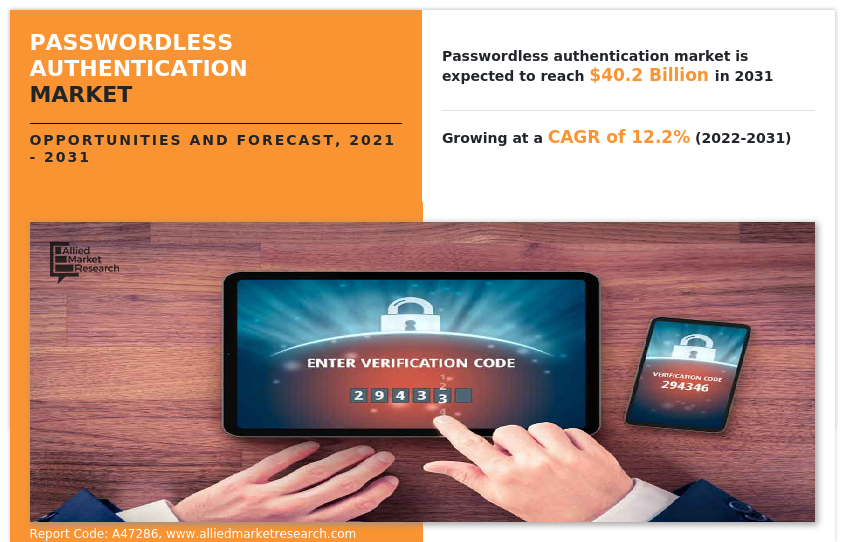
Platforms for identity and access management as well as individual systems may verify and authenticate users without the use of passwords with passwordless authentication. Users utilize alternate techniques to verify their identities, such as security tokens or biometrics. Multi-factor authentication often adds a second level of security to the password. Therefore, passwords are no longer necessary owing to passwordless authentication technologies.
Furthermore, due to dependability issues and security risks like cyber scams and man-in-the-browser vulnerabilities, old authentication techniques like knowledge-based authentication and SMS-based two-factor authentication are no longer regarded as recommended standards. In order to more reliably establish the online identities of new customers (during the account setup process) and current users for authentication events, modern online businesses are increasingly looking for facial authentication solutions. These events, particularly high-risk ones like wire transfers or password resets, are among the most common examples. Facial authentication has several real benefits over conventional authentication techniques.
The passwordless authentication market is expected to witness notable growth during the forecast period, owing to the growing advancement in technologies such as the internet of things (IoT) and artificial intelligence. Furthermore, the rising awareness of the application of passwordless authentication in the banking sector and the increase in penetration of consumer electronic devices has driven the growth of the market.
However, the increased cost of the deployment of passwordless authentications is the prime factor restraining the market growth. On the contrary, the surge in demand for cybersecurity and the adoption of the shift in authentication processes to enhance customer experience is expected to propel the passwordless authentication market growth, during the forecast period.
The global passwordless authentication market research is segmented into type, authentication type, industry vertical, and regions. Based on type, the market is bifurcated into authentication using face recognition (selfie authentication), challenge-response authentication mechanism (CRAM), fingerprint/thumbprint authentication, and others. By authentication type, the market is categorized into single-factor and multi-factor. Based on the industry vertical the market is segmented into aerospace & defence, BFSI, government & law enforcement, healthcare, IT & telecom, retail, transportation & logistics, and others.
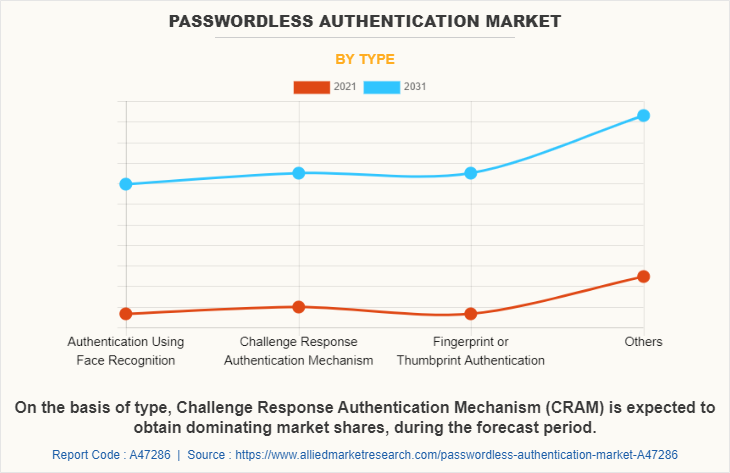
Passwords have served as protections over the years by preventing illegal access to one's data. With the development of technology, password usage has evolved and become much more secure while also being more user-friendly than it was previously. However, the flaws found and seen in this conventional approach have prompted businesses and researchers to seek alternatives where there is no risk of theft, hacking, or password cracking. Various types of passwordless authentication such as facial recognition, renal recognition, and smart are a few examples that authenticate a password-free secure access control system.
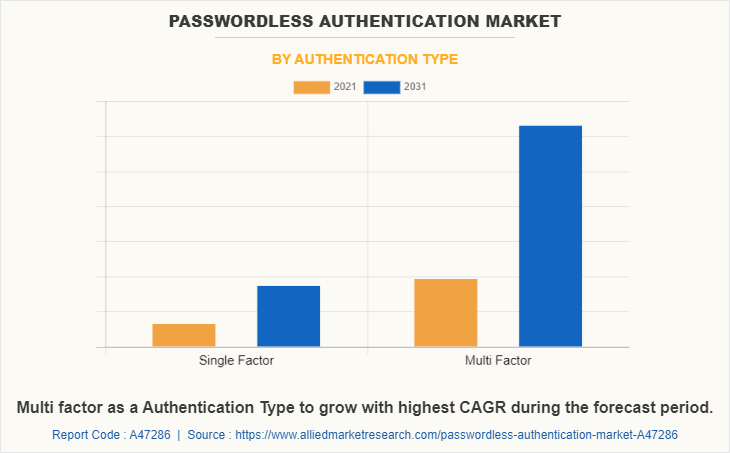
By moving verification to the device rather than sending credentials via an internet connection, passwordless authentication technology alters the fundamental security architecture. Although passwordless solutions are more advanced, traditional multi-factor authentication (MFA) still provides security and convenience to the authentication process. It's common for businesses to try to combine supply chain security, which is crucial for B2B financial infrastructure, with user experience and worker access security.
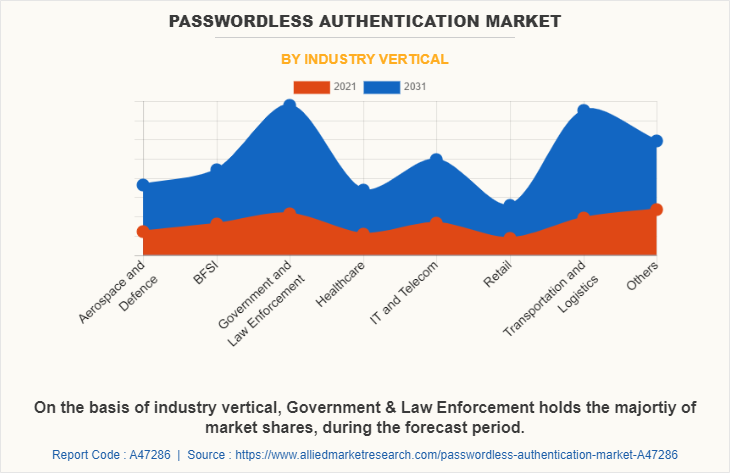
Such security solutions are still in high demand in the industry. Many businesses are still committed to helping SMEs overcome the hurdles of digitization and financial infrastructure. The banking industry is moving toward passwordless authentication as an additional layer of protection for its clients' accounts due to duplicate passwords across work and home accounts. There are many ways to lower risk in IT, but here is where professional security specialists are mostly focused. Passwordless authentication solutions are increasingly being employed in the banking industry due to the vulnerability of passwords and the possibility of password theft.
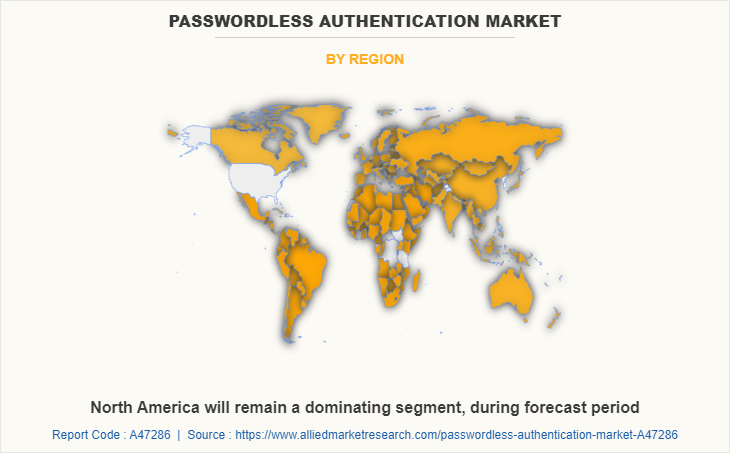
Region-wise, the passwordless authentication market trends are analyzed across North America (U.S. and Canada), Europe (Germany, Italy, France, Spain, UK, and the rest of Europe), Asia-Pacific (China, Japan, India, South Korea, and Rest of Asia-Pacific), and LAMEA (Latin America, Middle East, and Africa). North America, specifically the U.S. and Canada, remains a significant participant in the global passwordless authentication industry.
Top Impacting Factors
Due to the continuing development of technologies like the internet of things (IoT) and artificial intelligence, the market for passwordless authentication is anticipated to expand significantly throughout the projected period. Additionally, the market has grown as a result of increased consumer electronics device penetration and growing awareness of the use of passwordless authentication in the banking industry. However, the main issue limiting market development is the rising expense of deploying passwordless authentications. The expansion of the passwordless authentication market share, on the other hand, is anticipated to be fueled by the rise in demand for cybersecurity and the adoption of new authentication methods to improve customer experience.
Increase in Penetration of Consumer Electronic Devices
In order to access end-user logins and accounts, additional consumer gadgets are following the trend of increasing smartphone use. The growing usage of passwordless authentication as an additional layer of security on top of passwords is another factor driving the passwordless authentication industry. The swift adoption of technologies like artificial intelligence and the internet of things in consumer electronics like smartphones and tablets, among other items, has increased the demand for passwordless authentication. The problem of data theft on numerous devices, such as laptops, smartphones, and tablets, has also boosted the use of passwordless authentication.
Adoption of the Shift in Authentication Processes to Enhance Customer Experience
Many complicated, long passwords may be challenging for employees to remember. Passwordless authentication therefore greatly improves the user experience because there is no need to memorize passwords. If passwordless authentication is implemented and Single Sign On is enabled in Azure Active Directory, employees only need to log in once to access all frequently used apps and services.
For instance, the Microsoft Authenticator app, which is comparable to windows hello for business, debuted another passwordless authentication solution in February 2022 that uses either biometrics or a PIN. Users must have the Microsoft Authenticator app installed on their Android or iOS smartphone to use this option. This helps to detect the issue and save from data breaches, which fuels the market for passwordless authentication.
Competition Analysis
Competitive analysis and profiles of the major passwordless authentication market players, such as Cognitec Systems GmbH, Fujitsu Limited, Google LLC, HID Global Corporation, IBM Corporation, Microsoft Corporation, NEC Corporation, Okta, Secret Double Octopus (SDO), and Thales Group are provided in this report.
Regional Insights
North America is the leading region in the passwordless authentication market, primarily due to the early adoption of advanced authentication technologies and a strong emphasis on cybersecurity. The U.S. is at the forefront, with major tech companies and enterprises investing in passwordless solutions to mitigate risks associated with traditional password-based systems. The rise in data breaches and identity theft incidents has pushed organizations to adopt multi-factor authentication (MFA) and biometric solutions. The presence of key players like Microsoft, Google, and Okta also bolsters market growth in this region.
Europe follows closely, with countries such as the U.K., Germany, and France adopting passwordless authentication to enhance security measures across various sectors, including finance, healthcare, and government. The implementation of regulations like the General Data Protection Regulation (GDPR) has heightened awareness of data protection and privacy, driving organizations to seek secure authentication methods. Additionally, the growing trend of remote work and digital transformation initiatives is further fueling the adoption of passwordless solutions.
Asia-Pacific is witnessing the fastest growth in the passwordless authentication market. Countries like China, India, Japan, and Australia are increasingly investing in advanced authentication technologies to protect digital assets and streamline user experiences. The region's booming e-commerce and fintech sectors are key drivers, as businesses seek to enhance customer trust and secure transactions. The increasing use of biometric technologies, such as facial recognition and fingerprint scanning, is gaining traction as organizations aim to provide seamless access to their services.
Latin America and the Middle East & Africa are emerging markets for passwordless authentication. In Latin America, countries like Brazil and Mexico are beginning to adopt passwordless solutions in response to rising cyber threats and digitalization efforts. The Middle East, particularly the UAE and Saudi Arabia, is also investing in passwordless authentication as part of broader cybersecurity initiatives aimed at protecting critical infrastructure and enhancing user experiences.
Key Industry Developments:
- In September 2021, Microsoft announced enhancements to its Azure Active Directory, allowing users to sign in without passwords. This initiative is part of Microsoft’s broader strategy to promote secure and user-friendly authentication methods.
- In March 2022 The FIDO Alliance, which promotes passwordless authentication standards, expanded its membership to include more companies from various sectors. This growth underscores the increasing collaboration among industry leaders to drive the adoption of passwordless technologies globally.
- In March 2021: Okta completed its acquisition of Auth0. This acquisition aims to strengthen Okta’s position in the passwordless authentication market by providing more comprehensive solutions for developers and enterprises.
- In April 2023, Yubico launched the YubiKey 5C NFC, a passwordless authentication device that supports multiple protocols, including FIDO2 and WebAuthn. This product aims to provide users with a secure and convenient method for accessing services without passwords.
Key Benefits for Stakeholders
This study comprises an analytical depiction of the passwordless authentication market size along with the current trends and future estimations to depict the imminent investment pockets.
The overall passwordless authentication market analysis is determined to understand the profitable trends to gain a stronger foothold.
The report presents information related to key drivers, restraints, and opportunities with a detailed impact analysis.
The current passwordless authentication market forecast is quantitatively analyzed from 2021 to 2031 to benchmark financial competency.
Porter’s five forces analysis illustrates the potency of the buyers and suppliers in passwordless authentication.
The report includes the market share of key vendors and passwordless authentication market trends.
Passwordless Authentication Market Report Highlights
| Aspects | Details |
| Market Size By 2031 | USD 40.2 billion |
| Growth Rate | CAGR of 12.2% |
| Forecast period | 2021 - 2031 |
| Report Pages | 208 |
| By Type |
|
| By Authentication Type |
|
| By Industry Vertical |
|
| By Region |
|
| Key Market Players | Okta, Cognitec Systems GmbH, NEC CORPORATION, Fujitsu Limited, Google LLC (Alphabet), Microsoft Corporation, IBM Corporation, HID Global Corporation, Thales Group, Secret Double Octopus (SDO) |
Analyst Review
A security technique called passwordless authentication uses a few unique biological characteristics of the authenticated individual to confirm their identity. It is a method of authenticating users without the usage of passwords. Key providers in the passwordless authentication market are Google LLC, Microsoft Corporation, IBM Corporation, NEC Corporation, Thales Group, Okta, Fujitsu Limited, Cognitec Systems GmbH, HID Global Corporation, and Secret Double Octopus (SDO).
In addition, the quick uptake of technologies like artificial intelligence (AI) and the internet of things (IoT) in products like smartphones and tablets, is significant for the passwordless authentication market expansion. Identity verification is done via fingerprint sensors and smartcards, and these security points enable a seamless user experience and a smooth transfer of data across locations.
For instance, in September 2021, with biometric technology improving, Microsoft decided to introduce a completely passwordless verification tool for some of its products, and combine passwordless authentication with biometrics for users by using the Microsoft Authenticator app, a verification code sent to phone or email to sign in to apps and services, such as Microsoft Outlook, Microsoft one drive and Microsoft family safety. Such instances have propelled the growth of the passwordless authentication market.
Passwordless authentication has become popular in the digitalization era. It is used to describe a set of identity verification solutions that remove the password from all aspects of the authentication flow and from the recovery process as well. Therefore, organizations will remain competitive, secure, and compliant and have a modern authentication system that does not require users to remember passwords, by eliminating passwords as a method of authentication.
Many key players collaborated to provide better and enhanced passwordless authentification solutions to clients. For instance, in January 2022, HID Global and Citrix enables a passwordless way to work and provides passwordless future solutions that support a better authentication experience for Citrix Workspace users without sacrificing security. HID Crescendo can form the foundation of a complete multi-factor authentication ecosystem that not only enhances the security of Citrix environment but also the overall security posture of an organization. Such collaborations have propelled the growth of passwordless authentication market.
An increase in penetration of consumer electronic devices and growing advancement in technologies such as the internet of things (IoT) and artificial intelligence are the upcoming trends of the Passwordless Authentication Market in the world.
North America is the largest regional market for Passwordless Authentication.
Government & Law Enforcement, healthcare, IT & telecom, and retail are the leading industry verticals of the Passwordless Authentication Market.
Currently, Google LLC, Microsoft Corporation, IBM Corporation, NEC Corporation and Thales Group are some of the leading players in the passwordless authentication market.
Passwordless authentication market is valued at $12.8 billion in 2021.
Loading Table Of Content...


